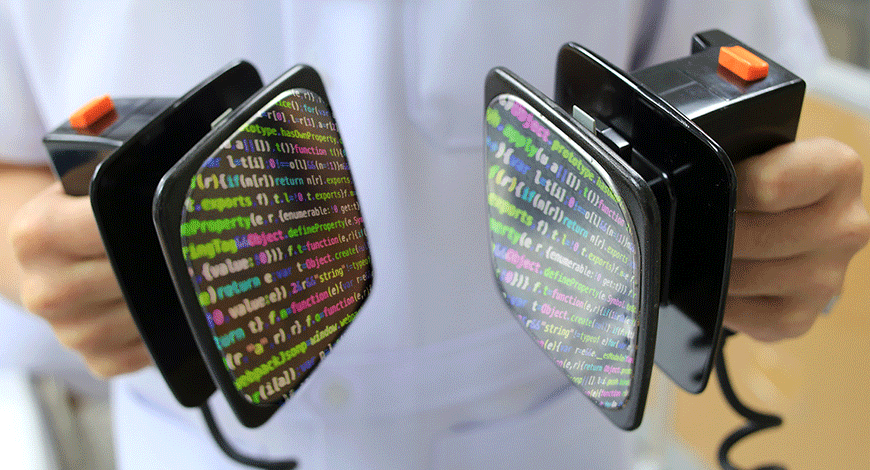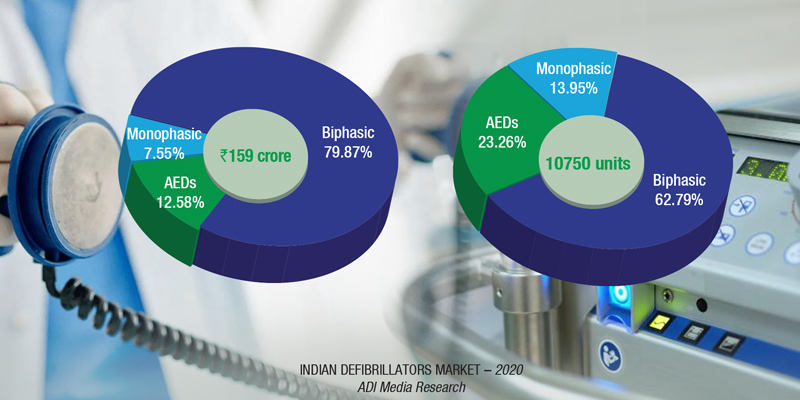Defibrilators
Biphasic defibrillation – The mainstay of resuscitation today

Biphasic devices are poised to completely take over the world, as many companies have stopped producing their older counterparts.
The external defibrillators have come a long way from large-sized, manually operated devices to current portable AED and wearable cardioverters and defibrillators. AEDs are an important part of the advanced cardiac life-support system for the treatment of sudden cardiac arrest. They are designed to be operated by a layman during an out-of-hospital cardiac arrest. Apart from automatic analysis of the cardiac rhythm and delivering appropriate therapy, today’s defibrillator-monitor also offers additional features of vital signs assessment like temperature, BP, 12-lead ECG, and wireless transmission of the waveforms to hospital ahead of the patient arrival, SpO2, carbon monoxide, and methemoglobin monitoring. They are also capable of giving audible CPR instructions and delivering higher energy to 360J. These can be used by both emergency medical personnel and code-blue medical teams of hospitals. Modern AEDs are made to meet the special needs of air-medical and defense operations also. Over the last three decades, AEDs have been upgraded with several new features, such as rechargeable batteries, LCD screens, voice prompts, CPR tutorials, sophisticated self-testing software, fully automatic operation, and new types of shocks.
Since their formal introduction in 1980, implantable cardioverter defibrillators (ICDs) have undergone innumerable design modifications, through several generations. They are indispensable today in successfully managing fatal ventricular arrhythmias. Their role in averting sudden cardiac death is recognized beyond doubt. Their applications and indications have continuously expanded over the last two decades. There have been several recent advancements in ICD technology to extend battery life, improvements in patient monitoring to avoid needless shocks, the introduction of quadripolar lead devices to improve device programming and to improve therapy effectiveness, and the development of magnetic resonance imaging (MRI)-safe ICDs. With more advanced detection algorithms, the potential integration with leadless pacing, and the possibility to serve as a remote monitoring device to recognize atrial fibrillation, acute ischemia, or electrolyte imbalance, the application of ICDs is rapidly evolving.
The global defibrillators market is expected to grow from USD 3.69 billion in 2020 to USD 4.00 billion in 2021 at a compound annual growth rate (CAGR) of 8.4 percent. The growth is mainly due to the companies rearranging their operations and recovering from the COVID-19 impact, which had earlier led to restrictive containment measures involving social distancing, remote working, and the closure of commercial activities that resulted in operational challenges. The market is expected to reach USD 4.62 billion in 2025 at a CAGR of 3.7 percent. The rising incidence of sudden cardiac arrest (SCA) is one of the major drivers of the defibrillator devices market.
Moreover, advanced defibrillator devices, rapidly growing geriatric population with elevated risk of targeted diseases, and increasing incidence of cardiac diseases among all ages are further driving the market growth.
The global external defibrillators market is dominated by automated external defibrillators and is expected to grow with highest rate in future, with increase in adoption by heart-failure patients across the globe.
The growing incidence of cardiovascular diseases and growing awareness regarding the lifesaving potential of AEDs have fueled the market growth. The second-largest market of external defibrillators is covered by manual external defibrillators, followed by wearable external defibrillators.
The Indian defibrillators market in 2020 is estimated at ₹159 crore, and 10,750 units. Biphasic defibrillators, at an 80-percent market share by value, are the mainstay. Accessories to record some parameters as ECG, SpO2, CO2, and NIBP may be added on to the system, as may CPRs, that are accessorized with biphasic models, often for the ambulances, and are retailed in the vicinity of ₹60,000–100,000 per unit.

Monophasic defibrillators are gradually exiting this segment. Only a handful of Indian brands manufacture them, and they find their way into small nursing homes, in smaller cities. They are no longer available in the international market.
The AEDs, already not gaining popularity over the last few years as they can be in a 1.4 billion population size, suffered a major setback in 2020. With government procurement funds diverted to devices used for COVID-19 healthcare, as oxygen concentrators and ventilators, AEDs were way down in the priority list.
|
Indian defibrillators market |
|
|
Leading players – 2020 |
|
| Segment | Some leading companies |
| Monophasic | BPL, UNI-EM, and Schiller |
| Biphasic | Premium: Stryker (Physiocontrol), Medtronic, and Zoll; |
| Mid-end: Philips, Nihon Kohden, Schiller, Comen, and Zoll; Mindray, GE, Stryker, Mediana, Beijing M&B, and BPL | |
| Automatic external | Philips, Zoll, Schiller, Beijing M&B, Stryker (Physiocontrol), Cardiac Sciences, Nihon Kohden, Primedic, and Defibtech |
| ADI Media Research | |
The first six months of 2020 were a total write-off in case of defibrillators, as they are not directly used in COVID-19 care. With the lockdown announced mid-March 2020, in any case, most public places as cinema halls, restaurants, airports, railway stations shut, there was barely any demand for AEDs.
September onwards, the market started picking up, and in 2021, so far sales are back to the pre-pandemic levels.
Despite the phenomenal advances in the medical and electronics fields during the last 30 years, the waveform technology used for external defibrillation has remained unchanged until very recently. As science and technology develop and evolve, so do these devices.
The very first defibrillators were monophasic devices, and they have been used for a long time until the invention of biphasic defibrillators. Even though the use of monophasic defibrillators continued, the biphasic devices have become more common so that many companies do not produce the older machines anymore. But it is impossible not to wonder about the quality of these defibrillators when compared side by side. Are biphasic defibrillators really better? They are not just trendy in the healthcare industry, lightweight, and easy to spot, but biphasic machines really are better than their older counterparts.
Reasons for the supreme position of biphasic machines are numerous – biphasic defibrillators can achieve higher efficacy but with the equal or even lower amount of delivered energy. At the same time, they also produce less impairment of cardiac function, which is always important.
Another benefit of biphasic defibrillators is that they normally do not produce other negative effects, such as skin burns, which can happen with their monophasic counterparts.
Moreover, since they require a lower amount of energy to produce the same effects, biphasic defibrillators are usually lighter, smaller, less demanding on batteries, and require lower maintenance than monophasic defibrillators.
On the flip side, monophasic devices can be quite bulky and impractical to handle in hectic situations. As the technology keeps progressing alongside science, biphasic machines are becoming more versatile and practical in terms of features and options they provide to rescuers.
Defibrillators have come a long way since their first implantation in humans in 1980, firmly cementing their place in preventing SCD. Despite four decades of continual design improvements and upgrades, defibrillators continue to evolve, and current research is ongoing to refine the ever-expanding indications for their use. With time, it is expected defibrillation will become more cost-effective and safer.











